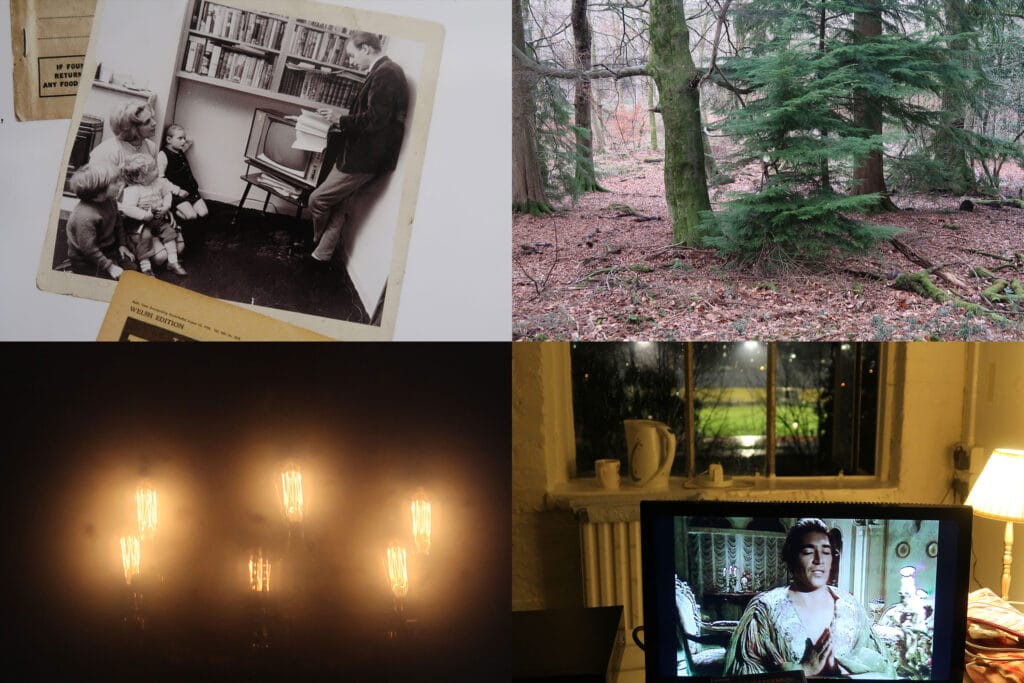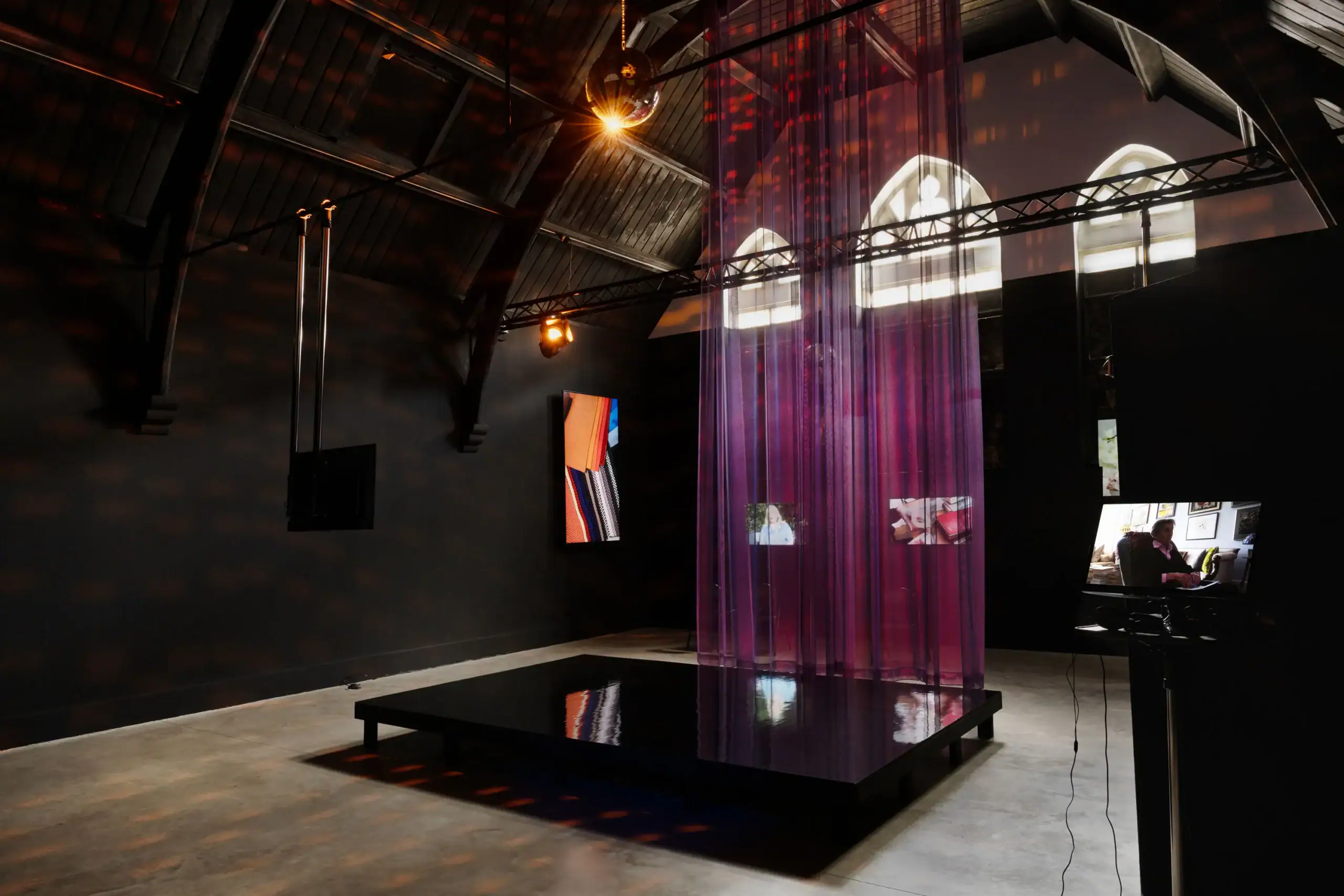This review was originally published in the October 2025 issue of The Critic.
It is not often that in an exhibition of video art, one wishes that there were more… content in it. Hilary Lloyd’s installation Very High Frequency brings together a dozen or so screens and projections of quasi-documentary footage reflecting on the life and work of the prolific dramatist Dennis Potter (1935-94), best remembered for his 1986 television drama The Singing Detective. Through interviews with Potter’s contemporaries, like the veteran BBC broadcaster Melvyn Bragg, and collaborators, including the actor Richard E. Grant, who starred in the 1996 Karaoke contemplating the playwright’s impending death, Lloyd conjures the atmosphere of the last time that Britain’s cultural institutions had the capacity for complexity and daring. In search of this complexity today, she mystifies Potter’s vast oeuvre itself.
Potter is only a half-likely candidate for a contemporary art gallery revival. His working-class roots and experience of Britain’s frail post-War meritocracy – subjects the writer exercised in his scripts like the 1965 Stand Up, Nigel Barton, which semi-fictionally takes him from a mining village to the University of Oxford – give any biographical framing of his work today an aspect of hollow nostalgia. Bragg, for example, contradicts this impulse and speaks of the “luck” involved in his and Potter’s careers, while Lloyd’s other interviewees give an account of him as exceptionally talented.
In Lloyd’s austere presentation in a room painted black, Potter’s work might appeal to our impoverished contemporary because it has a simplicity of means while taking on profound questions. For example, Potter was a regular contributor to the BBC’s Play for Today, which, as a format, beats Netflix in a hypothetical cost-to-impact-ratio competition hands down. Lloyd’s method of shooting from the hip and editing her work with the outdated iMovie software might give her some affinity with the screenwriter. But she acknowledges that the choice of the subject was the gallery’s, and it is not obvious from the hours of footage – some of it, like the monologue by Potter’s longtime producer Kenith Trodd, barely cut – that Lloyd is interested in discovering the work’s moral depth lest it distorts her own projection on it.
Whether it is the artist or the institution that is liable for their work’s transmission is not a new question. Potter’s powerful drama Brimstone and Treacle, filmed in 1976, wasn’t aired on the BBC for eleven years, judged too shocking for its depiction of a rape that miraculously cured its victim of her severe disability. Potter made out his perpetrator to be the Devil himself, turning everyone involved, including the girl’s caring parents, into accomplices. The act of censorship, which Potter claimed was entirely unexplained by the broadcaster, puts into question the fantasy of Britain’s once-great culture able to examine itself in the mirror. Today, Lloyd is at pains in interviews to suggest that she does not endorse all of Potter’s attitudes and politics, without, alas, spelling out what those are.

That might be in keeping with Potter’s method. Alongside the screening programme of his key works and interviews (including his conversation with Bragg filmed weeks before the writer’s passing from cancer, in which he alternates sips of champagne with liquid morphine), the exhibition becomes a morality play in which the viewer must decide whose actions – good or evil – have given rise to which – likewise good or bad – outcomes. Lloyd doesn’t make it easy. If there are hundreds of wayfinding references in Potter’s dozens of scripts, and hundreds more in Lloyd’s references to them, she follows the writer’s diversion of speaking aboutthem and not through them. This is what we mean when we think of aesthetics: Lloyd has The Teddy Bears’ Picnic play sporadically in the gallery, temporarily drowning out other sounds, without explaining the song’s relevance to The Singing Detective.
The difference between Potter’s and Lloyd’s aesthetics is that she, despite herself, turns history and its artefacts into a fetish. Lloyd stages her videos around a black podium, as though to invite the restaging of a scene from the 1978 Pennies from Heaven in which the protagonist escapes his drab existence into musical fantasy. Would that it were; Lloyd models a sequin dress on one of the screens.
Across the stage, she hangs a monitor on which two men in their thirties engage in heavy, passionate sexual foreplay in a forest setting. The ambiguous moral implication of this erotic work being so inserted into Potter’s legacy might find approval from him. Potter spoke of being sexually assaulted at the age of ten in the Forest of Dean, where he grew up. But Lloyd’s gay reprieve falls drastically short of the writer’s taste for the unresolvable. His first semi-autobiographical novel, Hide and Seek, has the protagonist confusing his assailant, framed by nature’s beauty, with God.

Potter could engage with “illness, death, sex, power, and class”, which the exhibition notes enumerate as though they were some extraordinary concepts, because he understood that his audiences were already contending with them, too. Lloyd thinks of them as “lived experience” and bites more than she can chew in a single sitting. Absent God and the Devil, however, this might be the only way through.
Hilary Lloyd, Very High Frequency, continues at Studio Voltaire, London, until 11 January 2026.
Main image: Hilary Lloyd, Very High Frequency, 2025. Installation view at Studio Voltaire. Image courtesy of the artist, Sadie Coles HQ, and Studio Voltaire. Photo: Dominique Croshaw.
